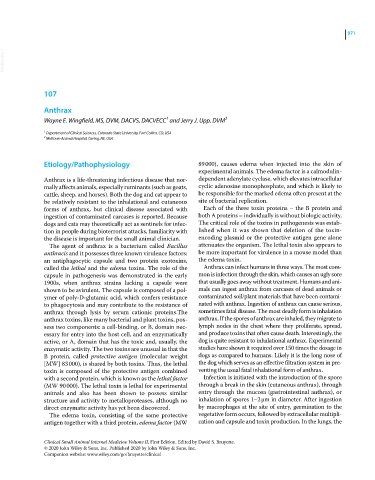Page 1033 - Clinical Small Animal Internal Medicine
P. 1033
971
VetBooks.ir
107
Anthrax
1
Wayne E. Wingfield, MS, DVM, DACVS, DACVECC and Jerry J. Upp, DVM 2
1 Department of Clinical Sciences, Colorado State University, Fort Collins, CO, USA
2 Midtown Animal Hospital, Gering, NE, USA
Etiology/Pathophysiology 89 000), causes edema when injected into the skin of
experimental animals. The edema factor is a calmodulin‐
Anthrax is a life‐threatening infectious disease that nor- dependent adenylate cyclase, which elevates intracellular
mally affects animals, especially ruminants (such as goats, cyclic adenosine monophosphate, and which is likely to
cattle, sheep, and horses). Both the dog and cat appear to be responsible for the marked edema often present at the
be relatively resistant to the inhalational and cutaneous site of bacterial replication.
forms of anthrax, but clinical disease associated with Each of the three toxin proteins – the B protein and
ingestion of contaminated carcases is reported. Because both A proteins – individually is without biologic activity.
dogs and cats may theoretically act as sentinels for infec- The critical role of the toxins in pathogenesis was estab-
tion in people during bioterrorist attacks, familiarity with lished when it was shown that deletion of the toxin‐
the disease is important for the small animal clinician. encoding plasmid or the protective antigen gene alone
The agent of anthrax is a bacterium called Bacillus attenuates the organism. The lethal toxin also appears to
anthracis and it possesses three known virulence factors: be more important for virulence in a mouse model than
an antiphagocytic capsule and two protein exotoxins, the edema toxin.
called the lethal and the edema toxins. The role of the Anthrax can infect humans in three ways. The most com-
capsule in pathogenesis was demonstrated in the early mon is infection through the skin, which causes an ugly sore
1900s, when anthrax strains lacking a capsule were that usually goes away without treatment. Humans and ani-
shown to be avirulent. The capsule is composed of a pol- mals can ingest anthrax from carcases of dead animals or
ymer of poly‐D‐glutamic acid, which confers resistance contaminated soil/plant materials that have been contami-
to phagocytosis and may contribute to the resistance of nated with anthrax. Ingestion of anthrax can cause serious,
anthrax through lysis by serum cationic proteins.The sometimes fatal disease. The most deadly form is inhalation
anthrax toxins, like many bacterial and plant toxins, pos- anthrax. If the spores of anthrax are inhaled, they migrate to
sess two components: a cell‐binding, or B, domain nec- lymph nodes in the chest where they proliferate, spread,
essary for entry into the host cell, and an enzymatically and produce toxins that often cause death. Interestingly, the
active, or A, domain that has the toxic and, usually, the dog is quite resistant to inhalational anthrax. Experimental
enzymatic activity. The two toxins are unusual in that the studies have shown it required over 150 times the dosage in
B protein, called protective antigen (molecular weight dogs as compared to humans. Likely it is the long nose of
[MW] 83 000), is shared by both toxins. Thus, the lethal the dog which serves as an effective filtration system in pre-
toxin is composed of the protective antigen combined venting the usual fatal inhalational form of anthrax.
with a second protein, which is known as the lethal factor Infection is initiated with the introduction of the spore
(MW 90 000). The lethal toxin is lethal for experimental through a break in the skin (cutaneous anthrax), through
animals and also has been shown to possess similar entry through the mucosa (gastrointestinal anthrax), or
structure and activity to metalloproteases, although no inhalation of spores 1–2 μm in diameter. After ingestion
direct enzymatic activity has yet been discovered. by macrophages at the site of entry, germination to the
The edema toxin, consisting of the same protective vegetative form occurs, followed by extracellular multipli-
antigen together with a third protein, edema factor (MW cation and capsule and toxin production. In the lungs, the
Clinical Small Animal Internal Medicine Volume II, First Edition. Edited by David S. Bruyette.
© 2020 John Wiley & Sons, Inc. Published 2020 by John Wiley & Sons, Inc.
Companion website: www.wiley.com/go/bruyette/clinical

